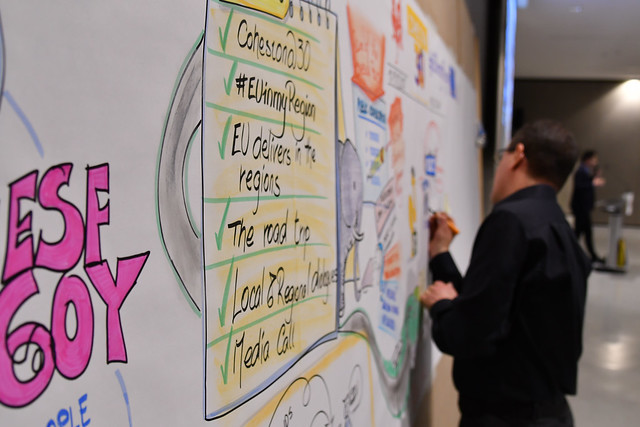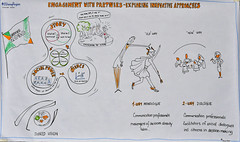
There are no magical rules to succeed! Only practice will help you to capture the essence of a speech, a presentation, a training, in… a short amount of time and space!
The practice consists in listen for key ideas, then recognize verbal cues that best identify these ideas and quickly replicate them through drawings and visual elements.
Preparation is key! What can you do in advance?
- Get as much information as possible on…
- the agenda: timing, talk points, breaks, etc, everything is precious
- the speaker(s): background, photo, speaking style and pace
- Prepare a library of possible icons and visuals on the subject by drawing them on a piece of paper from internet or Bikablo books
- Prepare your sketchnotes:
- Title, date, place, name of the speaker, twitter account/website, etc
- You can sketch the speaker from a photo, the location (Paris, Bxl, NY), etc
- Any footer with your signature?
- If you are sure, you can already draw lines with a pencil to divide the available space in sections
Before the start
- Choose a strategic place:
- To have a clear view [then not the back of the room, nor the first row]
- Comfortable enough to have your bloc-note and pens handy
- Like an athlete before a competition, put yourself in the right mental condition:
- Connect with yourself, with all your means, with your imagination and your fantasy
- Don’t be afraid, your role is not produce a full transcript [minutes takers are there for that, or not, not you]
- You can miss elements, don’t worry, your intuition will support you
- Breathe calmly and relax you
- Divide your paper in sections corresponding to the schedule but be VERY CAREFUL with that:
- Speakers are unpredictable:
- It’s better to capture what they really say, instead of anticipating what they had planned to say
- Don’t numbered in advance their points, they can skip a point to stay in time or they can forgot to mention it
- Remember that no law requires that your work is to be confined in one single page
Let’s go
- Depending on your skills/mood of the day, you can prefer to work in monochrome or using more colours (a maximum of 4 colours is recommended by Brandy Agerbeck). You can also postpone full colourisation for after the event and use my guide How to colour your drawings in 10 steps
- Depending on your preparation or intuition, you can opt for one of these models:
- Linear which is the most common, easiest, more secure. It can spread on several pages with a typical start from the top-left corner, then continue to the bottom or to the right
- Modulus like mind-map or web. Typical start from the center, use of lines to connect containers, any kind of lines and containers
- Grid like in comics
- Clouds
- Columns
- Timeline
- Random

- Stay focused on the main message and try to discard details that don’t reinforce it
- Forget to capture everything, that’s not the goal. What matters are your takeaways about what you considered important
- Note great quotes like tweets, represent them visually
- Draw simple objects in wire mode, especially people, you can come back on them later
- Use a pencil to write keywords on which you can come back later
- Use post-its (I use plenty of post-its)
Beforehand practice
- Search on sites like RSA, TED.com, Coursera for a short but inspiring speech and sketch it
- Do it alone, or better… with others in order to compare, explain, confront your ideas [community of practice principles]
- Build your own visual library by drawing in a sketchbook your icons to represent real objects like cup, pencil, doors, etc, and more abstract concepts like collaboration, idea, planning, etc.
Related post: To know what you’re going to draw, you have to begin drawing
In this second post, I expand my answer by talking about the importance of presence and listening.









